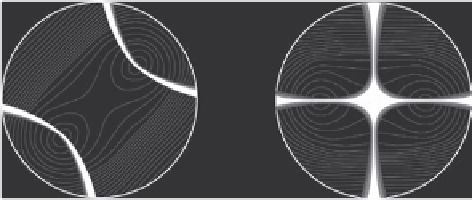Chemistry Reference
In-Depth Information
2.6.4 Biaxial mineral: section perpendicular
to the bisector of the acute angle
of the optic axes
Isochromes are close to ovals of Cassini. They are centered on the trace of
the optic axes in the plane of observation.
The isogyre appears as a rectangular hyperbola which admits the cross
hairs of the reticle (planes of polarization) for asymptotes and passes through
the trace of the optical axes. When you turn the stage, this hyperbole is
deformed and degenerates into a black cross four times per turn, when the
traces of the optic axes are in the planes of the cross hairs of the reticle. As the
section is perpendicular to the
acute
bisector, the hyperbola remains the field.
The eccentricity of the hyperbola thus depends on 2V: it is almost cross
for a small 2V, it is very open, at the limits the field of the microscope, for
2V close to 45°.
2.6.4.1 Determining optic sign
If we add an accessory plate (here quartz):
the mineral is
positive biaxial
,
is the bisector of the acute angle of the
optical axes: NE and SW quadrants take blue colors (higher in the inter-
γ
Figure 2.15
Convergent light interference figure of a biaxial mineral section cut perpen-
dicular to bisector the optic axes.
2V close to 40°
2V close to 5−10°
Figure 2.16
Estimation of 2V.

































